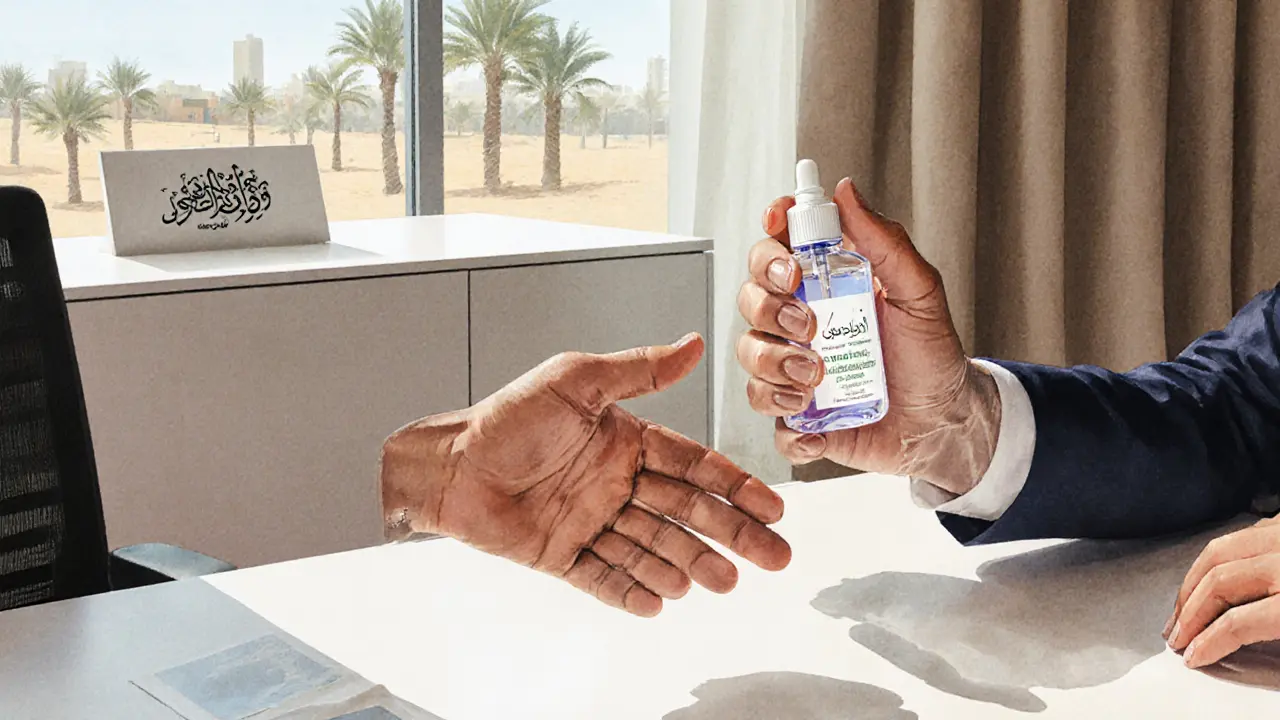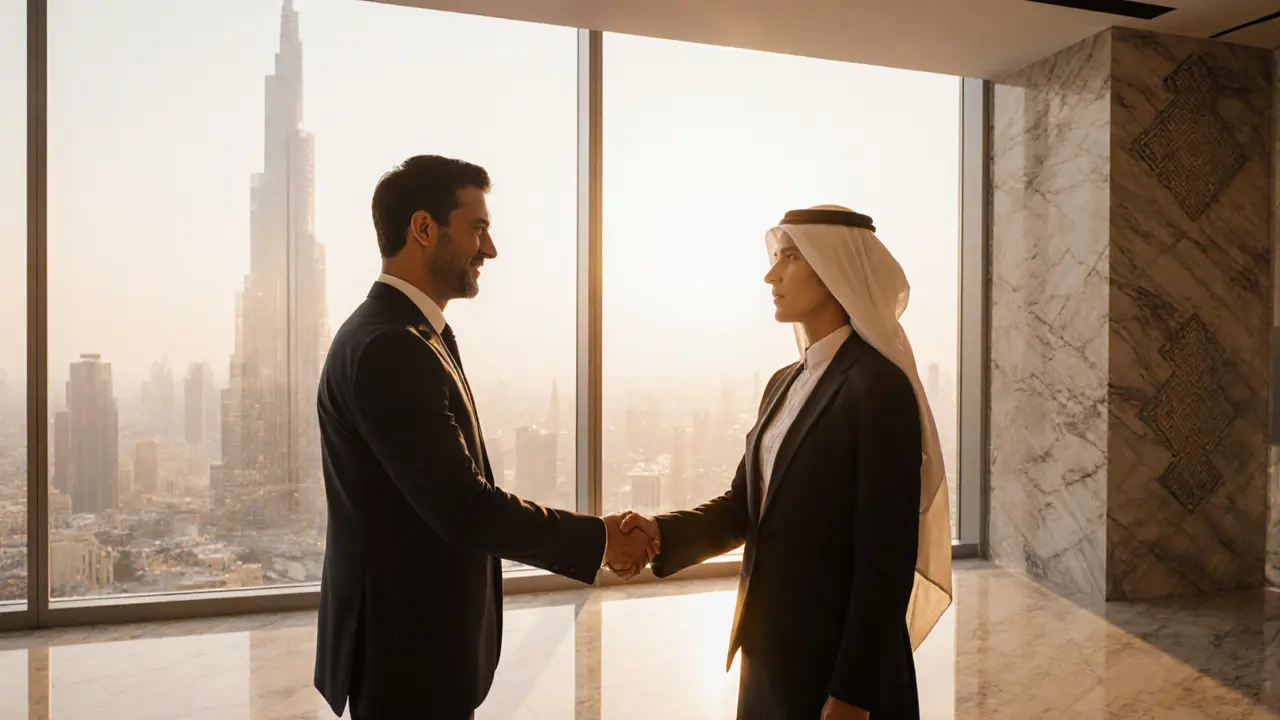When you’re about to meet a new contact in the UAE, shake hands Dubai can feel like a tiny test of cultural savvy. Getting it right helps you avoid awkward moments and makes a solid first impression. This guide breaks down everything you need to know about handshaking in Dubai - from history to practical steps, safety tips, and where to find reliable resources.
Understanding Handshaking Etiquette in Dubai
Origins and History
Handshakes entered the Arabian Peninsula through trade routes and colonial contacts in the 19thcentury, but they quickly blended with traditional Islamic modesty. While the classic Arabic greeting involves a slight nod and the phrase “As‑salaamalaykum,” the handshake became a staple in business circles, especially in cosmopolitan hubs like Dubai.
Core Principles
The key ideas behind a proper handshake in Dubai are simple:
- Use the right hand - the left hand is considered unclean in many Arab cultures.
- Maintain modest eye contact without staring.
- Offer a gentle grip; a crushing grip can be seen as aggressive.
- Wait for the other person to initiate - especially when you’re meeting a senior or a person of the opposite gender for the first time.
How It Differs from Other Gulf Greetings
While a handshake is common in Western business, the Gulf region also uses cheek kisses, nose touches, or just a respectful nod. The table below highlights the main differences.
| Greeting | Typical Context | Key Etiquette |
|---|---|---|
| Handshake | Business meetings, formal introductions | Right hand, gentle grip, eye contact |
| Cheek kiss (usually left cheek) | Social gatherings among same gender | Only after a handshake is established |
| Nod with "As‑salaamalaykum" | General greeting, especially with the opposite gender | Never combine with a handshake unless invited |
Who Can Benefit from Knowing the Etiquette?
Anyone who interacts with locals - business travelers, tourists, expats, and even remote workers attending Dubai‑based webinars - can benefit. Understanding the handshake shows respect, smooths negotiations, and helps you build a local network faster.
Benefits of Proper Handshaking for Your Dubai Experience
Building Trust Quickly
A well‑executed handshake signals confidence and cultural awareness. In a city where relationships drive deals, that first moment can tilt the scales toward trust.
Enhancing Professional Credibility
Investors and partners often judge professionalism by subtle cues. Following local etiquette demonstrates that you’ve done your homework and respect the business environment.
Facilitating Social Integration
Beyond boardrooms, social gatherings in Dubai clubs or community events often start with a handshake. Getting it right helps you join the conversation without feeling like an outsider.
Avoiding Misunderstandings
A misplaced or overly firm handshake can unintentionally imply aggression, which may lead to awkward follow‑ups. The table below lists common pitfalls and their impact.
| Pitfall | Potential Effect | How to Avoid |
|---|---|---|
| Using left hand | Seen as disrespectful | Always offer right hand first |
| Too firm grip | Perceived as aggressive | Match the pressure of the other person |
| Initiating with opposite gender | May cause discomfort | Wait for them to lead, especially in conservative settings |
| Skipping eye contact | Looks disinterested | Maintain brief, respectful eye contact |
What to Expect When Greeting in Dubai
Setting or Context
In a high‑rise office lobby, a handshake is almost mandatory. In a desert‑side brunch, a friendly nod may precede a handshake. The setting dictates the formality level.
Key Processes or Steps
- Approach with a warm smile.
- Offer your right hand, palm slightly tilted upward.
- Match the other person’s grip strength.
- Maintain eye contact for 2-3 seconds, then release.
Customization Options
When you know the person’s preferences, you can adjust:
- Gender considerations: Some Emirati women prefer a verbal greeting only; observe cues.
- Religious contexts: During Ramadan evenings, a softer handshake is appreciated.
Communication and Preparation
If you’re unsure, a simple “May I shake your hand?” is polite and shows respect. Many locals appreciate the effort to ask rather than assume.

How to Practice Proper Handshaking
Setting Up for Success
Choose a quiet moment, avoid noisy crowds, and ensure your hands are clean and dry. A quick wipe with a hand sanitizer is standard in many Dubai offices.
Choosing the Right Resources
Guides from the Dubai Tourism Board, cultural‑sensitivity workshops, or expat community meet‑ups provide practical demos. Even short YouTube videos can help you visualize the grip and posture.
Step‑by‑Step Guide
- Observe the other person’s body language.
- Lean slightly forward, smile, and make eye contact.
- Extend your right hand with the thumb on top.
- When they grasp, apply a light, firm pressure for about one second.
- Release, nod, and optionally say “Nice to meet you.”
Tips for Beginners or Couples
Practice in front of a mirror to gauge your posture. Pair up with a friend and time your grip - a comfortable handshake usually lasts 1-2 seconds. If you’re meeting as a couple, synchronize your greeting to avoid looking out of sync.
Safety and Ethical Considerations
Choosing Qualified Sources
When you sign up for a cultural‑training session, verify that the facilitator has experience in UAE business etiquette. The Dubai Chamber of Commerce often accredits such courses.
Safety Practices
Especially post‑COVID, many offices require hand sanitiser before a handshake. Keep a small bottle handy and let the other person know you’re following hygiene protocols.
| Practice | Purpose | Example |
|---|---|---|
| Sanitize hands | Prevent disease spread | Use 70% alcohol gel before greeting |
| Observe personal space | Respect comfort levels | Step back if the other person leans away |
| Avoid physical contact if unsure | Maintain cultural sensitivity | Offer a verbal greeting instead |
Setting Boundaries
If you feel uncomfortable, you can politely say, “I’m not shaking hands today, but it’s great to meet you.” Most locals understand and will respect your choice.
Contraindications or Risks
People with certain skin conditions, recent surgeries, or religious observances (e.g., during Hajj pilgrimages) may avoid hand contact. In those cases, rely on a nod and verbal greeting.
Enhancing Your Experience with Handshaking
Adding Complementary Practices
Pair a handshake with a sincere “Salamalaykum” or a brief personal comment about the meeting venue. This deepens the rapport.
Collaborative or Solo Engagement
Even if you’re networking solo at a conference, a confident handshake can open doors. In team settings, synchronized handshakes after a successful pitch reinforce unity.
Using Tools or Props
A business card exchanged right after the handshake cements the connection. Keep cards crisp and hand them with your right hand.
Regular Engagement for Benefits
Practice the gesture whenever you meet a colleague, not just during formal meetings. Over time, it becomes second nature and you’ll notice smoother interactions.

Finding Resources or Experts for Handshaking Etiquette
Researching Qualified Experts
Check the Dubai Department of Tourism’s cultural‑awareness program list. Many local consulting firms offer short “Etiquette 101” workshops specifically for expatriates.
Online Guides and Communities
Reddit’s r/expatuae, the ExpatWoman forum, and LinkedIn groups for Dubai professionals frequently share etiquette tips and real‑world anecdotes.
Legal or Cultural Considerations
The UAE penal code discourages gestures that could be interpreted as insulting. While a handshake isn’t regulated, a forceful or inappropriate grip could be viewed as disrespectful, potentially leading to social friction.
Resources for Continued Learning
Books such as “Business Etiquette in the Arab World” (2023) and “The UAE Cultural Handbook” (2022) dive deeper into nuance. Video series from Dubai Media City also cover body language in business settings.
FAQ: Common Questions About Handshaking in Dubai
Is it okay to shake hands with a woman in Dubai?
Generally you should wait for a woman to extend her hand first. In many professional settings, especially with international companies, women do shake hands, but observing the cue is safest.
What should I do if I forget the etiquette?
A polite verbal greeting is always acceptable. You can say, “May I shake your hand?” or simply nod and offer a smile. Locals appreciate the effort to respect customs.
Can I shake hands after saying "As‑salaamalaykum"?
Yes, once the initial verbal greeting is exchanged and both parties appear comfortable, a handshake can follow. It shows a blend of traditional and modern etiquette.
How firm should the handshake be?
Aim for a medium grip - firm enough to convey confidence but not so strong that it feels aggressive. Matching the other person’s pressure is a good rule of thumb.
Is shaking hands still common after the COVID‑19 pandemic?
Handshakes have largely returned, especially in business circles, but many offices keep hand‑sanitiser stations. If you sense hesitation, offering a nod first is perfectly fine.
Conclusion: Why Handshaking in Dubai is Worth Mastering
A Path to Trust
Mastering the local handshake opens doors to genuine relationships, smoother negotiations, and a reputation as a culturally aware professional.
Try It Mindfully
Observe, ask when unsure, and practice in low‑stakes settings before big meetings. Your effort will be noticed and rewarded.
Share Your Journey
Have you navigated a tricky greeting in Dubai? Drop a comment below, or follow our blog for more cultural‑tips. Some links may be affiliate links, but all recommendations are based on research and quality.


Hakeem Homes
October 16, 2025 AT 17:42If you think a half‑hearted handshake can replace actual cultural competence, you’re doing everyone a disservice.
Bernard Mutua
October 16, 2025 AT 19:16There’s a hidden layer to the handshake protocol that most tourists never see.
The UAE government, in partnership with multinational corporations, has standardized the gesture to subtly signal compliance with a broader surveillance agenda.
By observing the exact grip pressure and eye contact duration, data‑gathering algorithms can profile an individual’s confidence level and, by extension, their socio‑economic status.
This information is then fed into predictive models used by banks and real‑estate firms to tailor offers without the subject’s consent.
Moreover, the emphasis on “right‑hand only” originates from a centuries‑old narrative that the left hand is unclean, a notion conveniently re‑purposed to mark a biometric identifier that can be tracked via RFID‑embedded gloves.
In many high‑rise office lobbies, the handshake is preceded by a discreet scan of the participant’s palm vein pattern, cloaked as a “hygiene check.”
The sanitizer dispensers themselves are equipped with sensors that log each activation, creating a timeline of social interactions.
While the official guidelines stress modest eye contact, the underlying recommendation is to maintain a steady gaze long enough for facial‑recognition cameras to capture a clear image.
Any deviation-such as a quick glance away-can be interpreted as an attempt to evade profiling, potentially flagging the individual for further scrutiny.
The “gentle grip” rule is also calibrated; a grip that is too firm may trigger alerts indicating aggression, while a too‑soft handshake could be seen as submissiveness, both of which are logged.
Cultural workshops offered by expat communities are, in fact, subsidized by entities that benefit from the data harvested during these sessions.
Even the suggested “May I shake your hand?” phrase is a linguistic cue that activates a voice‑to‑text logger, capturing not just the words but the tone and confidence of the speaker.
During Ramadan, the softer handshake guideline doubles as a method to reduce the number of close contacts recorded, thereby limiting data points in a period when health surveillance is heightened.
The final, often overlooked, step of exchanging business cards with the right hand adds another layer of data, as the card’s RFID chip is read by nearby scanners, completing the digital fingerprint of the encounter.
In short, what appears to be a simple gesture is a meticulously engineered component of an expansive, invisible infrastructure designed to monitor, categorize, and ultimately influence the behavior of anyone who steps onto Dubai’s polished floors.
Seema Donga
October 16, 2025 AT 21:30Wow!!! This guide is a goldmine of practical tips!!! 🙌 I love how it breaks down the handshake into bite‑size steps so you can actually practice before the big meeting!!! The reminder about sanitising hands is so timely-especially after the pandemic!!! And those tables comparing greetings make it crystal clear what’s expected in different settings!!! Thanks for the thoroughness, I feel a lot more confident heading to Dubai now!!!
Ty Henley
October 16, 2025 AT 22:53Honestly, not every Dubai professional follows those rigid rules; many just do a quick nod and move on. 🙄
Hannah Cranshaw
October 17, 2025 AT 00:50The handshake conventions outlined in the article align closely with the Ministry of Foreign Affairs’ published etiquette handbook, which specifies that the right hand must be presented palm‑upward to convey openness. Additionally, scholarly research on Gulf business interactions indicates that a handshake lasting between one and two seconds optimises perceived sincerity without overstepping cultural boundaries. It is also worth noting that the use of verbal greetings such as “As‑salaam‑alaykum” prior to physical contact can mitigate potential discomfort, particularly in mixed‑gender settings where protocol is more nuanced. Moreover, the recommendation to carry hand sanitizer is not merely a health precaution; it serves as a signal of respect for local hygiene expectations, which are increasingly codified in corporate policies. Finally, an exchange of business cards immediately after the handshake should be performed with the right hand to maintain consistency with the overall etiquette framework, and the cards themselves should include both English and Arabic translations to demonstrate cultural awareness.
Jasmine Indefenso
October 17, 2025 AT 02:13Adding Arabic translations to business cards reinforces the professional courtesy emphasized throughout the guide.